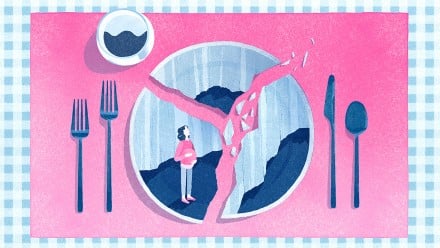What Happens if You Eat Paper While Pregnant
Bizarre food cravings when you're pregnant are no big deal. But pining for non-food items, like ice or clay? That's an eating disorder called pica and, although it can cause problems, it is treatable.
Pickles, ice cream and chips: These types of food cravings are a trademark of pregnancy and as common as swollen fingers and leg cramps. Such hankerings can increase in frequency and intensity when you're expecting and become quite specific—and sometimes just plain weird (Beyoncé's bananas and ketchup craving?). But when you have a compulsive urge to ingest substances that aren't food, like paint chips from the hardware store, cotton balls from the medicine cabinet or even something as seemingly innocuous as crunching on ice from the freezer, that's actually a condition known as pica, and it could signal a health issue that needs your doctor's attention.
What is pica?
People who have non-food cravings may have an eating disorder, according to the National Eating Disorders Association. This condition is characterized by the persistent consumption or even craving of non-food items with little or no nutritional value, such as dirt, clay, laundry detergent and, yes, even ice. Pica gets its name from the Latin word for "magpie," the bird with a penchant for eating almost anything.
What causes pica?
"We don't know for certain what causes pica, but it's believed to be an underlying nutritional deficiency, such as iron, or other physical or psychological concerns," says Karen Fleming, a physician in family medicine obstetrics at Sunnybrook Health Sciences Centre in Toronto. Although pica is pretty rare and can occur in pregnancy, it's more prevalent in kids, affecting up to one-third of children between the ages of one and six, according to the National Library of Medicine.
"Iron deficiency and other deficiencies [such as zinc and iodine] are very common in pregnancy, especially if there is a pre-existing condition or significant morning sickness," says Fleming.
What could it signal?
 Pregnancy is the eating disorder trigger that no one ever talks about"A red flag could be the overwhelming urge to start consuming non-food items," says Shawna Melbourn, a registered dietitian based in Ottawa. "If this leads to acting on that impulse by ingesting non-nutrition items, that's a clear indication and you should seek professional help." There are many reasons why nutrient deficiencies can arise."Sometimes, a mother isn't able to adequately nourish herself due to socio-economic factors or could be suffering from a mental illness and coping with unwanted feelings," says Melbourn. "But, regardless of the reason, it's not a choice that the mother makes."
Pregnancy is the eating disorder trigger that no one ever talks about"A red flag could be the overwhelming urge to start consuming non-food items," says Shawna Melbourn, a registered dietitian based in Ottawa. "If this leads to acting on that impulse by ingesting non-nutrition items, that's a clear indication and you should seek professional help." There are many reasons why nutrient deficiencies can arise."Sometimes, a mother isn't able to adequately nourish herself due to socio-economic factors or could be suffering from a mental illness and coping with unwanted feelings," says Melbourn. "But, regardless of the reason, it's not a choice that the mother makes."
What are some common cravings?
There's a wide range of non-food cravings, but the three most common ones are ice, cornstarch and clay. Among pregnant women, Fleming says that ice is typical and usually tied to an iron deficiency, which is odd because ice contains almost no iron. According to a recent study, the compulsion to consume ice during pregnancy has often been overlooked by clinicians. Often, an effective solution for this disorder is to take iron supplements.
Chalk is also a fairly popular one. "I loved eating chalk during both my pregnancies," says one mom in an online support group. Some women find earthy objects, such as dirt, rocks, clay, ash, charcoal and coal, satisfying, while others opt for stationery, such as pencils and paper. In the final few months of each of her four pregnancies, Blog by Baby blogger Danielle would crave bars of soap and have to nibble on them. Other common cravings include cloth, hair, string, wool, talcum powder and metal.
How can pica affect pregnancy?
Pregnant women are at an increased risk of nutrient deficiencies, particularly iron, as their requirements increaseto support fetal growth. "An iron deficiency can cause fatigue, affect sleep and have an impact on the red blood cells needed to support the mother and her growing baby," says Fleming."If women eat non–food items, there is the potential for toxicity and complications for mom and baby." Consuming non-food items can also interfere with eating healthy foods and taking in sufficient vitamins and nutrients to meet the growing demands of a pregnancy, which could lead to malnutrition and impede the health of mom and baby. The substances themselves can be toxic (paint chips), contain parasites or bacteria (dirt) or be indigestible (metal scraps), leading to issues such as constipation, intestinal obstruction, infection and malnutrition.
What treatment is recommended?
If you have a compulsion to chew on ice, a sudden urge to gnaw on a piece of your child's chalk or an itch to taste a handful of fresh garden soil, you should discuss this desire with your healthcare provider right away. There is no single test to diagnose the condition, but your doctor may test and monitor your blood levels of iron and zinc and test for anemia (when you don't have enough healthy red blood cells). They may also recommend that you see a dietitian, who can manage symptoms and help nourish the body by establishing an iron-rich diet or adding a supplement. As well, it could be beneficial to see a mental health professional or dietitian who deals with eating disorders or pregnancy, suggests Melbourn.
Read more:
While worrying about getting pregnant, my eating disorder slinked back
Healthy pregnancy snacks for moms-to-be
What Happens if You Eat Paper While Pregnant
Source: https://www.todaysparent.com/pregnancy/pregnancy-health/pica-pregnancy-eating-disorder/